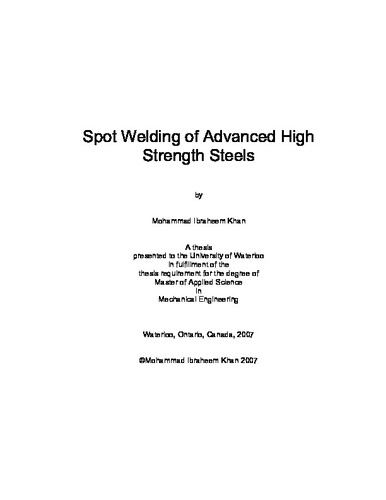| dc.contributor.author | Khan, Mohammad Ibraheem | |
| dc.date.accessioned | 2007-05-01 14:13:56 (GMT) | |
| dc.date.available | 2007-05-01 14:13:56 (GMT) | |
| dc.date.issued | 2007-05-01T14:13:56Z | |
| dc.date.submitted | 2007-04-20 | |
| dc.identifier.uri | http://hdl.handle.net/10012/2777 | |
| dc.description.abstract | Efforts to reduce vehicle weight and improve crash performance have resulted in increased application of advanced high strength steels (AHSS) and a recent focus on the weldability of these alloys. Resistance spot welding (RSW) is the primary sheet metal welding process in the manufacture of automotive assemblies. Integration of AHSS into the automotive architecture has brought renewed challenges for achieving acceptable welds. The varying alloying content and processing techniques has further complicated this initiative. The current study examines resistance spot welding of high strength and advance high strength steels including high strength low alloy (HSLA), dual phase (DP) and a ferritic-bainitic steel (590R). The mechanical properties and microstructure of these RSW welded steel alloys are detailed. Furthermore a relationship between chemistries and hardness is produced.
The effect of strain rate on the joint strength and failure mode is also an important consideration in the design of welded structures. Current literature, however, does not explain the effects of weld microstructure and there are no comprehensive comparisons of steels. This work details the relationship between the joint microstructure and impact performance of spot welded AHSS. Quasi-static and impact tests were conducted using a universal tensile tester and an instrumented drop tower, respectively. Results for elongation, failure load and energy absorption for each material are presented. Failure modes are detailed by observing weld fracture surfaces. In addition, cross-sections of partially fractured weldments were examined to detail fracture paths during static loading. Correlations between the fracture path and mechanical properties are developed using observed microstructures in the fusion zone and heat-affected-zone.
Friction stir spot welding (FSSW) has proven to be a potential candidate for spot welding AHSS. A comparative study of RSW and FSSW on spot welding AHSS has also been completed. The objective of this work is to compare the microstructure and mechanical properties of Zn-coated DP600 AHSS (1.2mm thick) spot welds conducted using both processes. This was accomplished by examining the metallurgical cross-sections and local hardnesses of various spot weld regions. High speed data acquisition was also used to monitor process parameters and attain energy outputs for each process. | en |
| dc.format.extent | 12795924 bytes | |
| dc.format.mimetype | application/pdf | |
| dc.language.iso | en | en |
| dc.publisher | University of Waterloo | en |
| dc.subject | Spot Welding | en |
| dc.subject | Advanced High Strength Steel (AHSS) | en |
| dc.subject | Resistance Spot Welding (RSW) | en |
| dc.subject | Friction Stir Spot Welding (FSSW) | en |
| dc.subject | Transformation Induces Plasticity (TRIP) | en |
| dc.subject | Dual Phase (DP) | en |
| dc.subject | High strength low alloy (HSLA) | en |
| dc.subject | Ferritic-Bainitic steels | en |
| dc.title | Spot Welding of Advanced High Strength Steels (AHSS) | en |
| dc.type | Master Thesis | en |
| dc.pending | false | en |
| dc.subject.program | Mechanical Engineering | en |
| uws-etd.degree.department | Mechanical and Mechatronics Engineering | en |
| uws-etd.degree | Master of Applied Science | en |
| uws.typeOfResource | Text | en |
| uws.peerReviewStatus | Unreviewed | en |
| uws.scholarLevel | Graduate | en |

